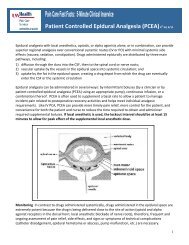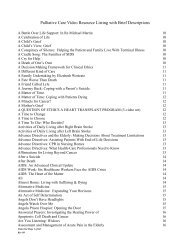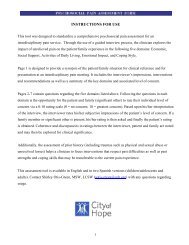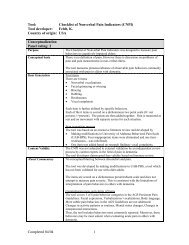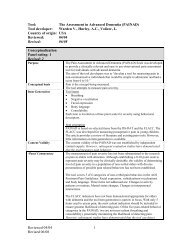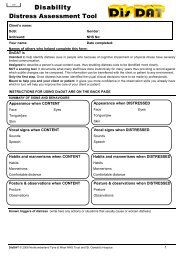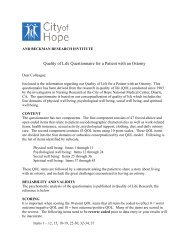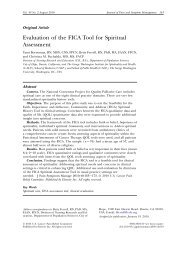1 Completed 06/08 Elderly Pain Caring Assessment 2 (EPCA-2 ...
1 Completed 06/08 Elderly Pain Caring Assessment 2 (EPCA-2 ...
1 Completed 06/08 Elderly Pain Caring Assessment 2 (EPCA-2 ...
Create successful ePaper yourself
Turn your PDF publications into a flip-book with our unique Google optimized e-Paper software.
Tool developers bring strong evidence for good convergent and discriminantvalidity and responsiveness of the <strong>EPCA</strong>-2. Factor analysis confirmed the 2 factors ofrest and caregiving pain and explained 56% of the variation in <strong>EPCA</strong> scores.It remains to be considered if the rule of analgesic use as gold standard forphysician proxy report is dependent on local practice patterns and reflects the tool’sinherent bias towards a large urban high acuity skilled care facility.SummaryThe <strong>EPCA</strong>-2 was developed using standard methods of item generation andconceptual validation. Tool evaluation was conducted in France on subjects withappropriate age and gender distribution but no diversity and no standardized assessmentof cognitive impairment. Preliminary internal and interrater reliabilities are moderatestrong.There was high convergent and discriminant validity and strong responsiveness ofthe tool to treatment in preliminary testing. The tool does require some training and timefor proper administration and has not been validated in English-speaking samplepopulations. This may limit its clinical utility in the US. Current psychometrics supportthe need for further evaluation in similar and diverse settings.The authors are finding that caregivers who are familiar with the patient find the<strong>EPCA</strong> less time-consuming to administer than measured in initial feasibility studies (Dr.Remy Morello, personal communication, July 20<strong>08</strong>).Source of evidenceMorello, R., Jean, A., Alix, M., Sellin-Peres, D., & Fermanian, J. (2007). A scale tomeasure pain in non-verbally communicating older patients: The <strong>EPCA</strong>-2 study of itspsychometric properties. <strong>Pain</strong>, 133(1-3), 87-98.Contact information:Remy MorelloEmail: morello-r@chu-caen.frReview completed by :K. Herr, H. Bursch and B. Black, The University of Iowa (20<strong>08</strong>).Contact address : keela-herr@uiowa.edu<strong>Completed</strong> <strong>06</strong>/<strong>08</strong>2




